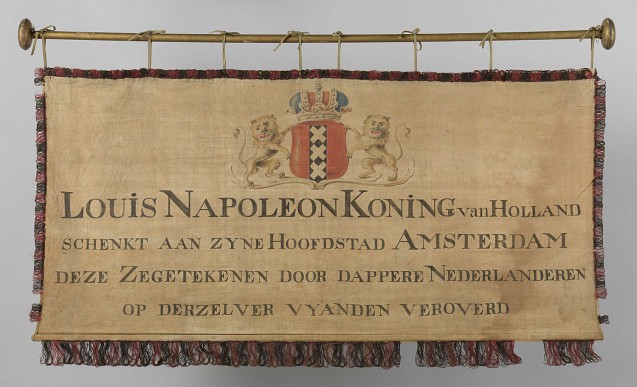On 5 June 1806, Napoleon appointed his brother, Louis Napoleon Bonaparte, King of Holland. This was a tactical decision on Napoleon’s part to limit Holland’s independence by installing a puppet ruler, but it did not go according to plan. Louis took his duties as King extremely seriously: he adopted the Dutch form of his name, Lodewijk I, advocated for his Dutch subjects, and even tried to learn Dutch, famously declaring that he was the “Rabbit of Holland” (“Konijn van ‘Olland”) rather than “King of Holland” (“Koning van Holland”). In spite of this linguistic blunder, Louis was well-liked by his subjects, who appreciated his compassion and devotion, nicknaming him “Louis the Good.”
This banner dates from 1806, shortly after Louis made his glorious entry into Amsterdam, which he had decided on for his kingdom’s capital. On 31 July 1806, he had the nation’s greatest military and naval trophies brought from the Binnenhof, seat of the Dutch Parliament in The Hague, to Amsterdam. This banner was flown at the head of the procession. Its text reads, “Louis Napoleon, King of Holland, presents to his capital Amsterdam these trophies seized by brave Netherlanders from their enemies”; above the text, Amsterdam’s coat of arms has been painted, surrounded by two lions and topped with the imperial crown.
Sadly, Louis’ reign was to be short-lived. On 1 July 1810, he was forced by his brother to abdicate, and on 9 July Holland was officially annexed by Napoleon to the kingdom of France. Louis had been the Netherlands’ first king, and it would be five years until they found another: William of Orange-Nassau declared himself King of Holland on 16 March 1815, in direct response to Napoleon’s return from Elba and the impending threat that reached its dramatic climax at Waterloo.
Francesca Whitlumcooper (December 2014)
Read more about this object on the website of the Rijksmuseum, Amsterdam


